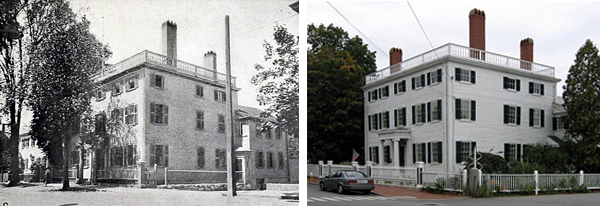The Strawbery Banke Museum
Visitors Center
is located at 14 Hancock Street .
The property includes forty structures located within the boundaries of Court
Street on the north, Washington
Street to the west, Marcy Street to the east, and Hancock Street to
the south.
Aldrich House
Chase House
Built around 1762, the Chase House was the home of Stephen
Chase, a prominent Portsmouth
merchant whose family entertained President George Washington here in 1789. It
later became the Chase
Home
Conant House
The Conant House is named for Aaron Conant, a stagecoach driver whose family lived here from 1834-1859.
Cotton Tenant House
This modest home was a rental property owned by Leonard Cotton, a prosperous Portsmouth merchant.
Gookin House
William Cotton, the son of Leonard Cotton, moved a small utility shed here and converted it to another Cotton tenant house.
Governor Goodwin Mansion
Originally located on Islington Street , the Goodwin Mansion New Hampshire from 1859-1861.
Hough House
Thomas Hough was a ship's carpenter who lived in the Hough House from 1851-1896.
Jackson House
This modest home was built around 1800 by the Jackson family of Portsmouth, who had owned this lot since 1695.
Jones House
Joshua Jones, a farmer and laborer, lived in this large house from 1796-1843.
Lowd House
A prosperous Portsmouth merchant named James Drisco built this home as a rental property in 1810. His widow sold the house to Peter Lowd, a barrel-maker, in 1824.
Marden-Abbott House and Store
After Walter Abbott died in 1938, widow Bertha Abbott single-handedly
ran a small grocery and sundries store here during the tough years of World War
II.
Penhallow House
Judge Samuel Penhallow constructed this building around 1750 to serve as his home and courtroom.
Reuben Shapley House
This large home was originally built around 1790 as a workshop or store by Reuben Shapley, a wealthy mariner, merchant, and shipbuilder.
Rider-Wood House
Samuel Jackson, who also built the Jackson House, constructed the Rider-Wood House between 1780 and 1800.
Shapiro House
Abraham and Shiva Shapiro, one of the first Jewish families in Portsmouth, lived in this home from 1909-1928.
Shapley-Drisco House
A mariner named John Shapley, brother of Reuben Shapley, built this home in 1794 and sold it to another mariner, James Drisco, five years later.
Sherburne House
The Sherburnes, one of the oldest families in Portsmouth, built this home circa 1695-1702. When Strawbery Banke Museum purchased the building in 1964, it had been converted to a typical suburban home of the period.
Stoodley's Tavern
Built by Colonel James Stoodley in 1761, the tavern hosted African slave auctions in the 1760s, and American patriots often gathered here at the time of the American Revolution.
Walsh House
Captain Keyran Walsh purchased this home in 1797 and died at sea ten years later.
Wheelwright House
John Wheelwright served as a 2nd Lieutenant on the USS Raleigh during the Revolutionary War.
William Pitt Tavern
Originally named the Earl of Halifax tavern, local patriots pressured John Stavers to rename his establishment in 1777. He chose to name it for William Pitt, a former British Prime Minister who was sympathetic to the American Independence movement.
Winn House, Yeaton House
Timothy Winn III and his brother-in-law, Thales Yeaton, built these connected houses in 1795.
Yeaton-Walsh House
Thales Yeaton rented this home to local workers, including Michael Walsh, a sawyer who lived here around 1850.








No comments:
Post a Comment